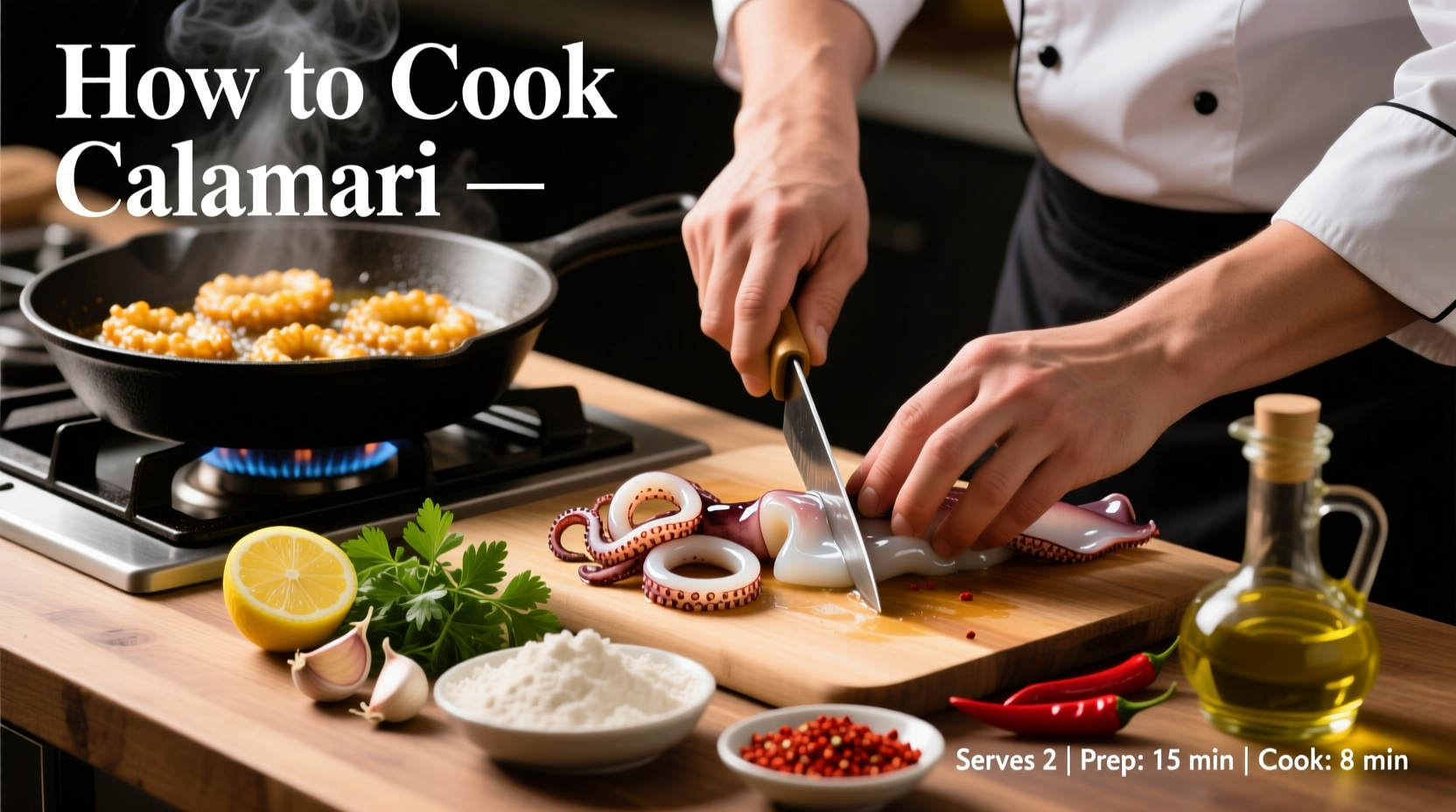Perfectly cooked calamari should be tender and flavorful, not rubbery. The key is cooking it quickly at high heat (1-2 minutes) or slowly at low heat (30+ minutes) to avoid the tough texture zone between 3-30 minutes. Always pat squid dry before cooking and never overcook - it turns rubbery within seconds.
Nothing ruins a seafood experience faster than tough, rubbery calamari. Many home cooks avoid squid altogether because they've experienced this disappointing texture. But with the right techniques, you can consistently create tender, restaurant-quality calamari at home. This guide reveals the food science-backed methods professional chefs use to transform this delicate seafood into a show-stopping dish.
Why Calamari Turns Rubber: The Food Science Explained
Calamari's texture problem stems from its muscle structure. Squid contains collagen that begins to contract at 120°F (49°C), reaching maximum toughness around 140-160°F (60-71°C). According to the FDA's Seafood Hazard Analysis Guide, squid proteins denature rapidly in this temperature range, causing the characteristic rubberiness.
| Cooking Method | Temperature Range | Time Required | Texture Result |
|---|---|---|---|
| Quick High-Heat | 400°F+ (204°C+) | 60-120 seconds | Tender with crisp exterior |
| Low and Slow | 180-200°F (82-93°C) | 30-60 minutes | Fall-apart tender |
| Middle Zone | 140-160°F (60-71°C) | 3-30 minutes | Rubbery and tough |
Selecting Quality Calamari: What to Look For
Fresh calamari should have a clean ocean smell, not fishy. The flesh should be firm with a slight sheen, and the color should range from milky white to light pink. Avoid any with yellow or gray discoloration. According to the NOAA Seafood Buying Guide, frozen calamari can actually produce better results than 'fresh' squid that's been previously frozen and thawed without your knowledge.
Preparation: Cleaning and Cutting Techniques
Most grocery store calamari comes pre-cleaned, but you may need to remove the thin skin. To do this:
- Blanch tentacles and tubes in boiling water for 15 seconds
- Immediately transfer to ice water
- Peel off the translucent membrane
For cutting:
- Rings: Slice tubes crosswise into 1/4-inch thick rings
- Steaks: Cut tubes lengthwise for grilling
- Tentacles: Leave whole or separate by size
Pro tip: Never soak calamari in milk as commonly suggested - research from America's Test Kitchen shows it doesn't tenderize and can create off-flavors.
Cooking Methods That Guarantee Tender Results
Quick-Fry Method (Most Popular)
This technique works because the high heat creates a crust before the interior overcooks:
- Heat oil to 375°F (190°C) in deep skillet
- Dry calamari thoroughly with paper towels
- Dip in seasoned flour or tempura batter
- Fry in single layer for 60-90 seconds until golden
- Drain on wire rack (not paper towels) to maintain crispness
Grilling Technique
Grilling requires precise timing:
- Preheat grill to high (450°F/232°C)
- Marinate in olive oil, lemon, and herbs for 15-30 minutes
- Place on hot grill grates
- Cook 60-90 seconds per side until grill marks appear
- Remove immediately - residual heat will continue cooking
Low and Slow Braising
For those who prefer fork-tender calamari:
- Simmer in tomato sauce or broth at 180-200°F (82-93°C)
- Cook for minimum 30 minutes
- Continue until calamari yields easily to a fork
- Finish with fresh herbs and lemon juice
Avoiding the #1 Calamari Mistake
Overcooking by even 30 seconds can transform tender calamari into rubber. Set a timer and watch carefully. Calamari is done when it turns opaque white and slightly firms up. Remember that it continues cooking off-heat, so remove it just before you think it's done.
Flavor Pairings That Elevate Calamari
Calamari's mild flavor pairs beautifully with:
- Citrus: Lemon, lime, or orange zest brightens the dish
- Herbs: Parsley, oregano, and fennel complement seafood
- Chilies: A touch of heat enhances without overpowering
- Acids: A splash of vinegar or wine balances richness
For authentic Italian preparation, finish with a squeeze of lemon and flaky sea salt. Spanish-style calamari benefits from smoked paprika and garlic.

Troubleshooting Common Calamari Problems
If Your Calamari Turned Out Tough
Don't throw it away! Transform rubbery calamari by:
- Simmering in tomato sauce for 45-60 minutes to break down proteins
- Chopping finely and using in seafood cakes or fritters
- Adding to soups where texture matters less
Preventing Soggy Fried Calamari
To maintain crispness:
- Double-fry method: First at 325°F (163°C) for 30 seconds, then at 375°F (190°C)
- Use rice flour instead of wheat flour for lighter coating
- Never crowd the pan - cook in batches
- Season immediately after frying while still hot
Perfect Calamari Every Time: Key Takeaways
Mastering calamari requires understanding its unique protein structure. Whether you choose quick high-heat cooking or slow braising, precise timing is essential. Always start with dry calamari, use proper heat management, and remember that carryover cooking continues the process. With these techniques, you'll consistently create tender, flavorful calamari that impresses even seafood connoisseurs.











 浙公网安备
33010002000092号
浙公网安备
33010002000092号 浙B2-20120091-4
浙B2-20120091-4